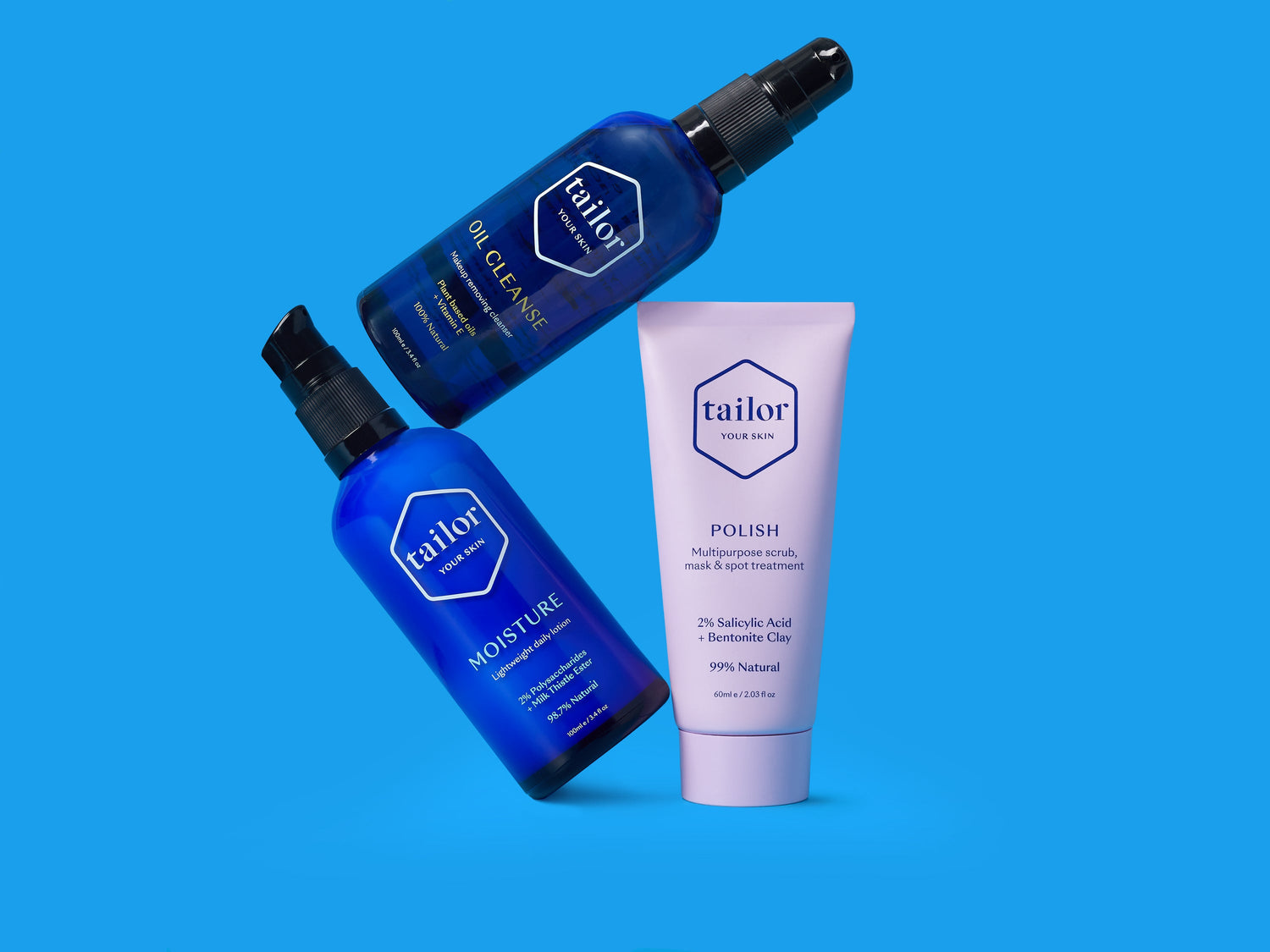Not all vitamin C skincare is created equal.
We’ve broken the science into 10 bite-sized chunks so you can ensure you’re getting the maximum benefit from Vitamin C when applying it to your skin and incorporating it into your diet. Chemistry not your forte? Don’t worry- check the sidebar notes for some quick definitions and explanations.
What is vitamin C?
Vitamin C is a powerful antioxidant found in abundance in the human skin. It helps to protect the skin from UV damage, boost collagen production, fade scarring, brighten the complexion, while also reducing hyperpigmentation, wrinkles, redness and breakouts. It’s part of a synergistic group of chemicals that exist to protect the skin from free radical damage and premature ageing. When the skin is exposed to UV light, pollution, toxins and other stressors, Vitamin C protects the skin from oxidative stress. It does this by donating electrons to neutralise free radicals, effectively halting the cascade of damage these destructive molecules cause.
SIDEBAR:
Free radical? Unstable atom, molecule or ion that bounces around the body looking for atoms to bond with. Enter: antioxidants. Antioxidants bond with free radicals and stop them from causing harm.
Vitamin C fights hyperpigmentation
SIDEBAR:
- Melanocyte: Melanin-producing cells
- Melanogenesis: When melanocytes produce melanin
- Tyrosinase: Speeds up the production of melanin
- Melanin: A natural pigment responsible for giving skin and hair its colour
In a study done by Hwang et al using Ascorbic Acid at 25%, a significant decrease in hyperpigmentation caused by melasma was reported after 16 weeks of topical Vitamin C (in the form of ascorbic acid) application. However, the clinical effects of Vitamin C may not be as pronounced as other topical chemicals like hydroquinone - a controversial skin bleaching ingredient.
SIDEBAR:
Melasma? Skin condition in which brown patches appear on the face.

ABOVE: Results of using Gold Dust and Moisture over four weeks.
Method: use week on, week off.
Vitamin C promotes collagen production
As well as having antioxidant protective benefits to the skin, Vitamin C is essential for collagen production. Collagen is a key structural protein in the skin. It’s responsible for keeping skin firm and strong. An abundance of collagen is found in youthful skin, whereas collagen begins to deplete as skin ages, resulting in wrinkle formation. In order for our body to synthesise collagen, the precursor “procollagen” is formed by the amino acids glycine and proline. Vitamin C has a key role in the formation of the polypeptide chains which make up procollagen.
Vitamin C has also been reported to assist with collagen stability via an interaction with enzymes prolysyl and lysyl hydroxylase, this is also referred to as the hydroxylation of collagen, and this process increases extracellular stability and support of the epidermis.
SIDEBAR:
Importance of collagen stability? Stable collagen is less likely to be destroyed by environmental stressors. Keeping your skin looking more youthful for longer. Lastly, Vitamin C helps to turn on collagen gene expression. This was observed in a 2009 study by Duarte et al where Vitamin C played a key role in the stimulation of DNA repair in cultured fibroblasts.
In short, Vitamin C plays several key roles in collagen production. We like collagen because it helps our skin to maintain its structure and stay looking youthful.
What is photoaging?
Photoaging is damage caused to the sun by UV exposure. Vitamin C limits the damage but shouldn’t be confused with SPF in sunscreen as it doesn’t absorb or reflect UVA or UVB rays away from the skin. It protects the skin from photoageing using an antioxidant mechanism to neutralise free radicals. When the skin is exposed to UV light, pollution, toxins and other stressors which cause free radical damage, Vitamin C protects the skin from this oxidative stress. Vitamin C donates electrons to neutralise the free radicals, effectively halting the cascade of damage these destructive molecules cause.
SIDEBAR:
It’s been widely documented that skin exposure to UV can lower Vitamin C levels in the skin. Meaning it’s important to apply Vitamin C topically along with eating foods rich in Vitamin C after exposure to UV light. This will help the skin replenish its Vitamin C levels. A 2009 study done by Farris et al found a UV protective effect by Vitamin C. Using an application of 10% Vitamin C showed a statistically significant reduction of UVB induced erythema at a rate of 52% along with sunburn cell formation by 40-60%. This further emphasizes the benefit of post sun topical application of Vitamin C.
Vitamin C reduces inflammation
Vitamin C is a NFkB inhibitor. NFkB (nuclear factor kappa-light-chain-enhancer of activated B cells) is a protein responsible for the activation of pro-inflammatory cytokines. This protein plays a key role in causing inflammation. Vitamin C is a NFkB inhibitor, which means it plays a key role in the inhibition of inflammation in the body and skin. This is important for inflammatory skin conditions like acne vulgaris and rosacea. Vitamin C can have a positive effect to reduce the inflammation associated with these conditions.Stability vs. Bioavailability
Above we’ve highlighted some pretty incredible benefits Vitamin C can provide to the skin. However, the benefits of Vitamin C cannot be achieved if you’re using a form which is not bioavailable to the skin. Bioavailability to the skin is the ability for your skin to utilise Vitamin C to produce the desired benefits above. There appears to be a trade off between Vitamin C stability in a skincare formulation and bioavailability to the skin. It’s commonly observed that new forms of Vitamin C (vitamin c derivatives) are synthesised in the lab and created to be stable in a formulation. However when applied to the skin the Vitamin C derivative must change back to ascorbic acid before it can be bioavailable to the skin.
For example the addition of a phosphate group can increase Vitamin C stability - creating a new and more stable synthetic form of Vitamin C however it’s bioavailability to the skin is often limited. That said, recent studies suggest encapsulation of ascorbic acid into a lipospheric form may be a game changer - by assisting with transport into the lower layers of the epidermis and could result in increased uptake. However, this technology uses synthetic chemicals and is therefore unavailable in Tailor Skincare products. On the flip side natural Vitamin C or ascorbic acid is widely considered as the most bioavailable form of Vitamin C. However it’s famous for its instability in skincare formulations. This video by the Australian Institute of Personal Care Science highlights the instability of Ascorbic Acid by using heat and light as variables.
So here at Tailor Skincare we took it upon ourselves to create a product which would harness the benefits of Vitamin C in the form of naturally derived ascorbic acid and Tailor Gold Dust was created. It’s not as simple as rubbing Vitamin C powder on your face to get the desired benefit. Gold Dust is a high maintenance product for our customers out there who want to take their skincare routine to the next level.

The roles of PH and oils
Vitamin C in dry crystal form is the first step to unlocking the bioavailability of ascorbic acid. However there are a couple of other things which need to happen along side this for your skin to benefit from this powerful antioxidant and this is because of the way your epidermis is structured. A main factor of what makes Vitamin C bioavailable is the pH level. Ascorbic acid must be formulated at a pH level of 3.5 to enter the skin. Applying pure Vitamin C is not for anyone with sensitive skin as the material can tingle upon application.
In addition to this, topical delivery of Vitamin C into the skin is complicated because of the lipophilic (oil loving) nature of the outer epidermal layers. Vitamin C is a hydrophilic material meaning it has an affinity for water. According to Belinda Carli, Director of the Institute of Personal Care science Vitamin C “being coated in a lipophilic substance will actually help with epidermal delivery.” Basically, in order to penetrate into the skin it’s important to pair Vitamin C with an oil loving material or skincare formulation containing oils or oil loving materials (like Tailor Renew or Moisture).
Vitamin C & E Synergy
Vitamin E has been found to work synergistically with Vitamin C to help with cell regeneration (collagen production) and photoprotection! Both antioxidants work in their respective hydrophilic and lipophilic compartments of the cell to limit UV damage and reduce cell apoptosis (cell death).
Topical vs. Dietary
 Similarly, including foods rich in Vitamin C into your diet is very important because it’s unlikely that topically applied Vitamin C will make its way past the epidermal layers and into the dermis. As explained above, the dermis has a reliable blood supply therefore it has access to dietary nutrients carried into the skin from the blood.
Similarly, including foods rich in Vitamin C into your diet is very important because it’s unlikely that topically applied Vitamin C will make its way past the epidermal layers and into the dermis. As explained above, the dermis has a reliable blood supply therefore it has access to dietary nutrients carried into the skin from the blood.
The human body cannot make ascorbic acid like many plants and animals can. We lack an essential enzyme (L-glucono-gamma lactone oxidase) which is responsible for converting glucose into Vitamin C. Dietary sources of Vitamin C are fundamental not only for skin health but for general health.
Vitamin C & E rich foods


Top tips for vitamin C in skincare:
- Apply Vitamin C to the skin after sun exposure to help replenish your skin’s Vitamin C levels.
- Apply pure Vitamin C to the skin in the form of ascorbic acid at a pH of 3.5
- Mix Vitamin C with a water & oil based cream or serum and immediately apply to the skin
- Look for water and oil based creams and serums which contain Vitamin E to boost the efficiency.
- Take an internal and external approach to your skincare routine by applying Vitamin C & E topically and adding foods rich in these vitamins to your diet.


